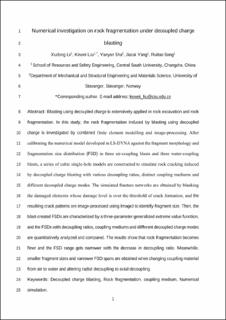| dc.contributor.author | Li, Xudong | |
| dc.contributor.author | Liu, Kewei | |
| dc.contributor.author | Sha, Yanyan | |
| dc.contributor.author | Yang, Jiacai | |
| dc.contributor.author | Song, Ruitao | |
| dc.date.accessioned | 2023-11-29T13:47:39Z | |
| dc.date.available | 2023-11-29T13:47:39Z | |
| dc.date.created | 2023-02-27T14:32:49Z | |
| dc.date.issued | 2023-05 | |
| dc.identifier.citation | Li, X., Liu, K., Sha, Y., Yang, J. & Song, R. (2023) Numerical investigation on rock fragmentation under decoupled charge blasting. Computers and geotechnics, 157, 105312 | en_US |
| dc.identifier.issn | 0266-352X | |
| dc.identifier.uri | https://hdl.handle.net/11250/3105251 | |
| dc.description.abstract | Blasting using decoupled charge is extensively applied in rock excavation and rock fragmentation. In this study, the rock fragmentation induced by blasting using decoupled charge is investigated by combined finite element modelling and image-processing. After calibrating the numerical model developed in LS-DYNA against the fragment morphology and fragmentation size distribution (FSD) in three air-coupling blasts and three water-coupling blasts, a series of cubic single-hole models are constructed to simulate rock cracking induced by decoupled charge blasting with various decoupling ratios, distinct coupling mediums and different decoupled charge modes. The simulated fracture networks are obtained by blanking the damaged elements whose damage level is over the threshold of crack formation, and the resulting crack patterns are image-processed using ImageJ to identify fragment size. Then, the blast-created FSDs are characterized by a three-parameter generalized extreme value function, and the FSDs with decoupling ratios, coupling mediums and different decoupled charge modes are quantitatively analyzed and compared. The results show that rock fragmentation becomes finer and the FSD range gets narrower with the decrease in decoupling ratio. Meanwhile, smaller fragment sizes and narrower FSD spans are obtained when changing coupling material from air to water and altering radial decoupling to axial decoupling. | en_US |
| dc.language.iso | eng | en_US |
| dc.publisher | Elsevier Ltd. | en_US |
| dc.rights | Attribution-NonCommercial-NoDerivatives 4.0 Internasjonal | * |
| dc.rights.uri | http://creativecommons.org/licenses/by-nc-nd/4.0/deed.no | * |
| dc.title | Numerical investigation on rock fragmentation under decoupled charge blasting | en_US |
| dc.type | Peer reviewed | en_US |
| dc.type | Journal article | en_US |
| dc.description.version | acceptedVersion | en_US |
| dc.rights.holder | © 2023 Elsevier Ltd. | en_US |
| dc.subject.nsi | VDP::Teknologi: 500::Berg‑ og petroleumsfag: 510::Geoteknikk: 513 | en_US |
| dc.subject.nsi | VDP::Matematikk og Naturvitenskap: 400::Geofag: 450 | en_US |
| dc.source.volume | 157 | en_US |
| dc.source.journal | Computers and geotechnics | en_US |
| dc.identifier.doi | 10.1016/j.compgeo.2023.105312 | |
| dc.identifier.cristin | 2129686 | |
| dc.source.articlenumber | 105312 | en_US |
| cristin.ispublished | true | |
| cristin.fulltext | postprint | |
| cristin.qualitycode | 1 | |

